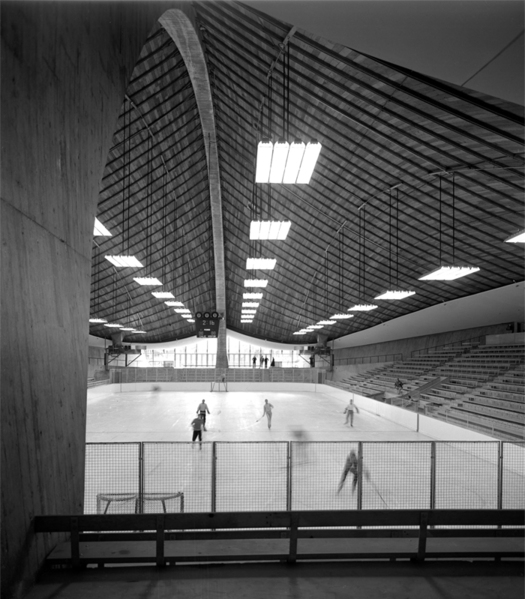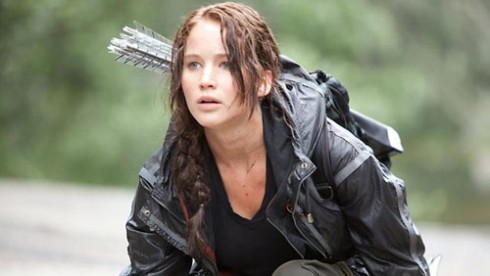
David S. Ingalls Skating Rink, New Haven (1958), Eero Saarinen & Associates © Pedro E. Guerrero (Courtesy Edward Cella Art + Architecture)
No, not together.
This week I had the pleasure of writing about two seemingly opposed design artifacts: the gorgeous architectural photography of Pedro E. Guerrero, who worked with Frank Lloyd Wright for 20 years and palled around with the Harvard Five in New Canaan, CT, and the dystopian future presented in the movie version of the best-selling young adult novel The Hunger Games.
The first piece is a Q&A for the New York Times “Home” section, and I found the 94-year-old Guerrero to be in fine form, still creating art in the form of junk sculpture. The first career retrospective of his work opens April 5 at the Woodbury Hollywood Gallery in Los Angeles, curated by Anthony Fontenot and Emily Bills (coincidentally, a classmate and friend from my days at the Institute of Fine Arts). He had a lot to say about the architects and sculptors whose work he photographed, including Breuer’s first Connecticut house. One memory, cut for space in the Times, was of his first encounter with Alexander Calder.
PG: I was working for House & Garden and they were doing a series of stories on men’s influence in the kitchen. They asked me to photograph Alexander Calder’s kitchen. I knew that most magazines will use photographs only if they can take the photographs that will be in the article and show them to an advertiser and say, How would you like to advertise in the issue because we are showing this kitchen that has a GE stove or refrigerators? I went into Calder’s kitchen and he had three stoves, one was 30 years old, one was not operating at all, it was a wood stove with a gas burner. He had made the kitchen and he had made all of Louisa Calder’s implements. House & Garden turned it down, and I knew they would. I asked them if I could have the photographs for myself. I called Calder and asked if I could elaborate on what I had already done.
AL: I assume it wasn’t just the kitchen he made himself.
PG: Oh no, everything. He might have bought a few things. He really hadn’t been successful financially until he was in his 60s. But even after he was able to afford to buy things, he still preferred to flatten out an olive oil can and put a frame on it to make a tray out of it.
Guerrero also praised a lesser-known New Canaan architect, Joseph Salerno, who designed the photographer’s house and the spectacular United Church of Rowayton, CT.

United Church of Rowayton (1962), Joseph Salerno ©Pedro E. Guerrero
PG: Joe Salerno designed my house in New Canaan, and I became his photographer. I did six or seven of his projects, but the church he designed in Rowayton was by far the most spectacular. He was inspired a little bit by Mr. Wright’s handling of materials. Looking at the photographs now all these years later, I was stunned by how beautifully had had designed it, how every inch seemed to have come out of his own hand and his own pencil.
AL: It sounds like your relationship with the architect was very important.
PG: I’ve only turned one job down. Somebody asked me to photograph some architecture and when they asked me why not I told him it looked like a parking lot full of Winnebegos.
AL: Do you remember who that architect was?
PG: I do but don’t want to mention his name.
I won’t be able to go to the exhibition, open through April 25, but I am hoping some of my West Coast readers will. It is high time we expanded the canon of midcentury modern architectural photographers beyond Julius Shulman, Ezra Stoller and Hedrich Blessing.

Effie Trinket (Elizabeth Banks) and Katniss Everdeen (Jennifer Lawrence) in The Hunger Games (Lionsgate)
Meanwhile, you didn’t think Design Observer could remain Hunger Games-free, did you? I enjoyed the first book of the trilogy, and am always interested in going along for the pop cultural ride, so I saw the film the weekend it opened. I was immediately struck by the beauty of the film’s opening scenes, set in a region of the fictional Panem called District 12, but made over into 1930s Appalachia. There seemed to be a very consistent visual story being told in architecture, design and fashion. Unfortunately, that consistency didn’t make it all the way through the movie, and I think the softening of the story noted by many movie critics carried over into a softening of the design story.
Despite the glut of coverage for the movie, both Angela Riechers and I noticed no one was talking about the design, so we engaged in a critical conversation for The Atlantic blog. It is very spoilery, so be warned.
A few highlights. First, on the beginning, photography and fashion.
AL: I think so. The opening scenes in District 12 are atmospheric and period precise. The bleached-out blue palette, the wooden shacks, the muddy roads—you know you are in the 1930s of the Farm Services Administration photographers. There were a couple of moments, like the line of cabins going down into the hollow, or the two scrawny kids looking out of a hole in the wall, that I could almost swear were direct imitations of a photograph. I found out after I saw the movie that those scenes were filmed in Henry River, North Carolina, an abandoned mill town from the 1920s. In District 12, it is coal. In North Carolina, it was yarn.
AR: The set for the Reaping was in fact an old cotton gin in Shelby, North Carolina, where we get the first visual clue hinting at the hideousness to come. The softly draped, drab cotton clothing (defenseless, helpless, defeated) worn by the District 12 kids contrasts very sharply with the architectural, brightly colored clothing (aggression, assault, dominance) worn by Effie Trinket. Her clothes are cruel. Like armor that uses harsh color and shape to intimidate.

Katniss Everdeen (Jennifer Lawrence) with REI windbreaker and glass-fletched arrows (Lionsgate)
Second, on realism and weapons design.
AL: The only other design note I have from the arena was the glass-tipped arrows Katniss picked up. The other weapons and windbreakers looked like they could have come from REI. It would have been more realistic if she'd had trouble using these arrows at first, or taken a moment to notice the glittering ends. You would think her homemade feathered arrows would shoot differently.
AR: There are many extremely hi-tech bows for hunters already on the market, with crazy futuristic designs. I was surprised not to see more of this kind of stuff. It would have been interesting to see that Darwinian angle come into play: Can Katniss and the others adapt quickly enough to the new equipment to survive? I also wish there'd been tech-geeky stuff for the tributes to use, for instance a laptop that would 3-D print advanced weaponry—just as the people in the control room could create scary dogs on a moment's notice. The weapons for combat were almost medieval.
The architecture of Hunger Games was undistinguished, with the notable exception of the Cornucopia, which immediately brought Frank Gehry’s Pritzker Bandshell in Chicago to mind. The training rooms for the tributes also seemed like a missed opportunity. There were a few concrete supports for plotters to hide behind, but the production designers could have underlined the ominous nature of this training (we’re not in high school gym anymore), and the artificiality of the Capitol, by incorporating more heroic Breuer-inspired tree-shaped columns. Such an architectural reference still would have been retro, but at least it would have used design to amplify the drama.
